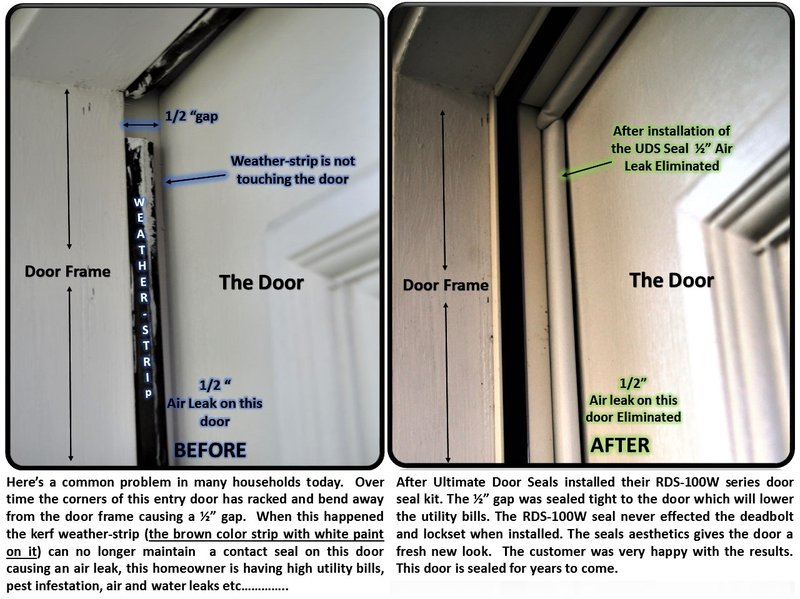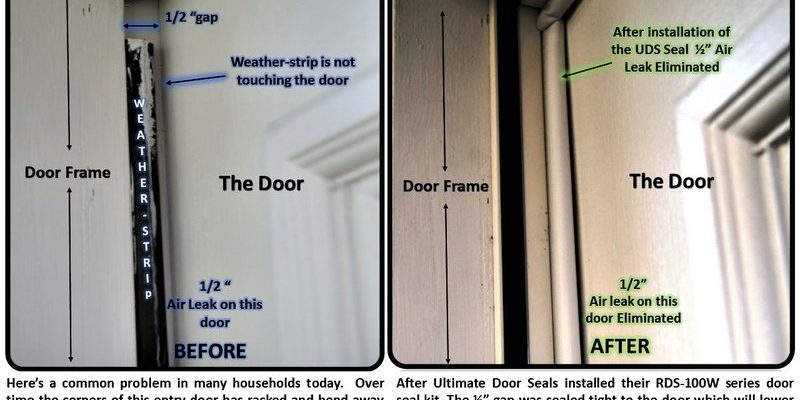
You might be thinking a door seal is a pretty simple thing: just a strip of rubber or vinyl that keeps out air and water, right? In theory, yes. But in practice, that little weatherstrip has a tough job. Every time you open, close, or even slam your door, you’re putting it to the test. And unless you’re dealing with a high-end Marvin or Andersen door, a basic seal can break down sooner than you’d expect. Does it matter if you’ve got a steel, fiberglass, or classic wooden door? You bet it does. The brand and build play a big part in how long your door can keep the rain at bay.
Common Reasons Exterior Door Seals Let Water In
Let’s start with the obvious: *most* exterior door seal leaks come down to either age, installation problems, or physical damage. After a few years of daily use—especially in wild weather—the rubber or foam that forms the seal can start to wear out, crack, or pull away from the door frame. Maybe a dog scratched at it, or maybe a heavy package knocked it loose. With brands like Therma-Tru, Pella, or JELD-WEN, you’ll find weatherstripping rated for years of use, but even the best seals eventually lose their grip.
Another big culprit is poor installation. Even a sturdy, brand-new door can leak if the installer skipped a step, went too fast, or didn’t line things up just right. If the seal was cut too short, glued in crooked, or left a tiny gap at the bottom corner, water will find a way. Here’s the thing: water doesn’t need a gaping hole to sneak through—a tiny gap is enough, especially in wind-driven storms.
Sometimes, the trouble isn’t with the seal at all, but with the threshold. If the aluminum or composite threshold plate under your door is warped, loose, or not angled right, water can pool up and push under the seal—no matter how perfect it looks. And in older homes, shifting foundations or settling can slowly twist the frame and make the seal “miss” part of the door.
How to Spot the Signs of a Failing Door Seal
You might be wondering: how do you tell if it’s really the seal, or something else? Take a close look after the next rainstorm. If you see moisture along the bottom edge or sides of the door, run your hand along the weatherstripping while the sun’s out. Does it feel hard, brittle, or cracked? You might see flat spots where the rubber doesn’t bounce back anymore. These are all signs your exterior door seal is failing.
A favorite trick of pros is to shine a flashlight from outside at night while someone is inside with the lights off. If light seeps through the edges, water can too. You’ll also want to check for visible gaps—look from the inside out during the day, and see if you can spot daylight at any point around the door.
Keep in mind: sometimes the leak appears a few inches away from the door, thanks to water running along subfloors or baseboards. In those cases, peel back the weatherstripping and inspect underneath. If you see rot, swollen wood, or rusty metal fasteners, you’re dealing with more than just a minor leak.
What Happens If You Ignore a Leaky Door Seal?
Let me explain why this little problem demands attention. Water leaks, even small ones, can do a lot more than just annoy you with puddles. If water keeps seeping past your door seal, it can:
- Warp hardwood or laminate floors
- Stain or rot your subfloor or framing
- Attract pests like ants or termites
- Encourage mold, mildew, and that musty basement smell
*Mold* is especially sneaky. It can grow inside walls or under flooring where you can’t see it—leading to big headaches down the line. And if your home insurance company learns the issue was preventable (say, you ignored water at the door for months), they might deny your claim for repairs.
Bottom line: Catching a bad seal early can save hundreds (or thousands) in repair bills. If you have a smart home system that monitors moisture or humidity, like a sensor synced to your phone or home hub, you might catch these leaks even sooner. But most people notice the old-fashioned way: damp socks and mysterious puddles.
How Door Seal Designs and Brands Affect Water Leaks
Not all door seals and brands are created equal. You’ll see big differences between a basic builder-grade seal and those on high-end doors like Andersen or Pella. Some use a single rubber blade, while others have multiple “fins” or even magnetic strips to create a tighter seal. The material—foam, vinyl, silicone, or rubber—changes how the seal flexes and how long it lasts.
A well-designed door seal isn’t just about blocking water; it also needs to compress just right when the door closes without making it hard to open or latch. Universal weatherstripping kits are easy to find, but may not fit your exact door model (or brand). Using a universal seal on a specialized door can leave little gaps, especially at the corners or bottom sweep.
Here’s an example: if you swap a damaged Schlage or Kwikset door sweep with a random universal model, you could lose the tight fit the original brand designed for its unique frame. The result? More leaks, not less. It’s almost like trying to use a universal remote without syncing it properly—things might sort of work, but not perfectly.
Tip: Always check your door’s make and model before shopping for replacement seals. Most brands list their recommended parts on their websites, and you can often find how-to videos for pairing the right seal to your specific door.
How Weather, Use, and Maintenance Shorten Seal Life
The life of a door seal isn’t just about brand quality—it’s about what you put it through: wild weather, careless use, and regular wear and tear. If your door gets full sun all afternoon, the UV rays can dry out and crack even premium seals. In cold climates, freezing and thawing can make rubber stiff and brittle.
Frequent use is another factor. Let’s say you have a busy family, pets, or just love to go in and out all day. Every swing of the door compresses and pulls on that seal, wearing it down little by little. And if you ever move heavy furniture or haul in deliveries, a single knock or scrape can tear the rubber or foam, even if the rest looks fine.
Maintenance matters, too. If you rarely clean the bottom sweep, dirt and grit can grind away the seal every time you open or close the door. If you paint the doorframe and accidentally coat the seal, you can trap moisture and encourage it to rot away faster. Like syncing your universal remote or resetting a smart lock, keeping your door seal in top shape is all about regular checks and quick fixes.
Step-by-Step Troubleshooting: How to Fix a Leaky Door Seal
So you’ve spotted a leak—what next? There’s a simple troubleshooting code you can follow to find and fix the problem:
- Inspect the seal — Look for cracks, gaps, flattening, or missing sections up and down the door’s edge and bottom sweep.
- Check the threshold — Make sure it’s tight, level, and has a proper slope. If you feel movement or see daylight below the door, it may need to be reset or shimmed.
- Pair the right replacement — Match the seal to your door’s brand and model, or at least get a close fit. Bring a piece of the old seal to the hardware store if you’re unsure.
- Remove the old seal — Gently pry it loose. Clean the frame and groove so new adhesive or compression fits snugly. Make sure no debris or old glue stays behind.
- Install the new seal — For adhesive types, press firmly for even contact. For push-in or snap-in types, align and press them into the grooves all around the door. Don’t forget the bottom sweep!
- Bettle-test your fix — Close the door from inside and check for light leaks. Spray a little water with a hose (not a flood!) along the bottom and watch for drips inside.
If the seal keeps leaking after you’ve replaced it, you might need to reset the threshold, adjust the door, or—if all else fails—call a pro for a full weatherproofing job. Sometimes, frame rot or foundation shifts can throw everything off, and that’s a bigger fix.
Comparing Door Seal Types: Universal vs Brand-Specific
When it comes to replacing an exterior door seal, you’ll find two main options: universal seals and brand-specific replacements. Universal weatherstripping kits are everywhere—they fit most “standard” doors, and they’re cheap and easy to install. But honestly, they’re a one-size-fits-all approach, which means they might not be a perfect fit.
Brand-specific seals, like the ones for Pella, Masonite, or JELD-WEN, are designed to sync exactly with their frames and sweeps. They take a little extra effort to find, maybe even a special order, but once installed, they seal better and last longer. Think of it like using the correct remote code or pairing a device the right way—when all the parts match, everything works together smoothly.
Here’s a quick comparison table for clarity:
| Universal Door Seal | Brand-Specific Door Seal |
| Fits most doors, easy to find | Exact match for door model/brand |
| Typically cheaper | Usually more expensive |
| May require trimming/adjusting | Precise fit, easier install |
| Might not seal perfectly at corners | Best for preventing leaks and drafts |
If budget’s tight or you’re renting, universal might do fine for a quick fix. For a long-term solution—especially in wild weather—brand-specific seals are usually worth the extra effort.
When to Call a Pro or Consider a Full Door Replacement
Here’s the honest answer: if you’ve replaced the seal, checked the threshold, and water still finds a way in, it’s time to bring in a professional. Persistent leaks can hint at bigger issues, like hidden rot, shifted frames, or even a warped door slab itself. A door expert or home repair contractor can assess the whole setup, maybe reset the frame, or recommend a new door if repair isn’t cost-effective.
You might also want to upgrade if your current door is very old, hollow, or damaged beyond a simple seal swap. Modern exterior doors from brands like Therma-Tru or ProVia offer better weather resistance and improved seals that last longer and keep your home more energy-efficient. Just like upgrading to a new, better remote when the old one won’t sync any more, a new door can solve stubborn problems for good.
Don’t put off a call for help just because it seems minor—water damage grows fast, and acting early is always cheaper than a big repair later.
The Bottom Line: Keeping Your Home Dry Starts With the Right Seal
A leaky exterior door seal can go from small annoyance to big problem faster than you’d think. Whether you’re troubleshooting a puddle after rain or just keeping an eye out for future leaks, it pays to know how your door seal works, what causes them to fail, and how to fix or replace them the right way. The right seal, fitted properly, keeps water outside—where it belongs—so you can keep your socks dry and your home safe from hidden damage. Next time you spot a drip or draft near the door, don’t wait; check that seal and stay a step ahead.
